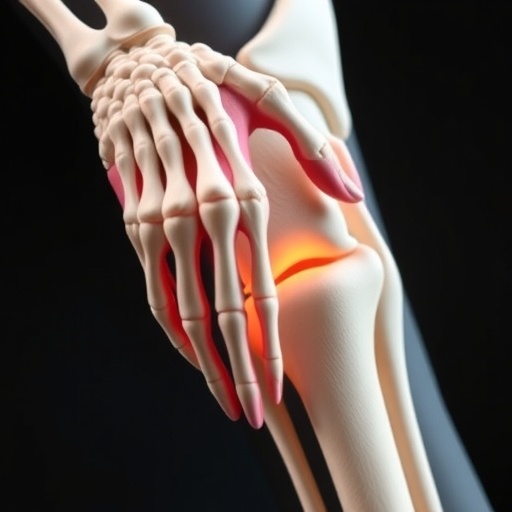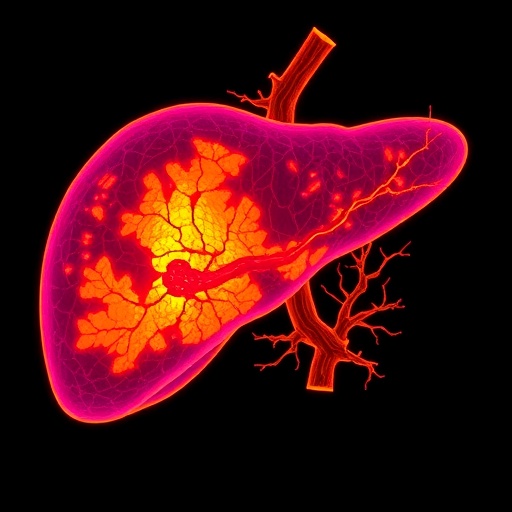
A groundbreaking study has emerged highlighting a compelling discordance observed in bone age assessments between the knee and the hand-wrist in adolescents. This research, spearheaded by a team including Yu Sun, Zhou Zhou, and Zheng X, sheds light on the multifaceted implications of skeletal maturity evaluation, particularly in relation to thyroid-stimulating hormone (TSH) levels. As skeletal development plays a crucial role in pediatric medicine, understanding these discrepancies is vital for clinicians in providing effective treatment and monitoring growth-related issues in youths.
The significance of bone age assessment cannot be overstated, especially in adolescents whose growth patterns vary markedly. Traditionally, bone age evaluations leverage X-ray imaging of the hand and wrist, which relies on established standards depicting average maturation timelines. However, recent findings suggest that these standards may not be universally applicable, pointing to nuanced variations in how bone age manifests across different regions of the skeletal system, particularly the knee versus the hand-wrist area.
In the study, various adolescents underwent both hand-wrist and knee radiographic assessments to evaluate bone age. Inconsistent results surfaced, prompting researchers to investigate the potential causes and implications of these disparities. The knee—often overlooked in standard evaluations—may present different developmental timelines influenced by several factors, including genetic predispositions and environmental influences, which can directly affect hormonal secretion and, subsequently, overall maturity.
Understanding the implications of these findings extends beyond the mere diagnosis of skeletal age. It invites a broader discussion surrounding the processes governing growth and development, particularly as they relate to hormonal influences. For instance, elevated levels of thyroid-stimulating hormone have been identified as a significant factor in the growth processes. Assessing the relationship between TSH and skeletal maturity can unlock new pathways for targeted interventions in growth disorders and improve the accuracy of predicting final adult height in adolescents.
The discordance observed between these two skeletal assessment methods raises critical questions regarding best practices in pediatric endocrinology. The capacity to accurately gauge skeletal maturity influences treatment decisions, particularly in conditions that warrant hormonal therapies or interventions aimed at promoting growth. Establishing a clearer understanding of skeletal age can assist clinicians in tailoring their approaches to individual patient needs based on unique growth patterns rather than relying on generalized standards that may not adequately reflect a patient’s specific physiological state.
Moreover, findings from this research prompt a re-evaluation of current methodologies employed in bone age determination. As radiologists and pediatricians alike seek the most effective means of assessing skeletal maturity, integrating findings from these studies may play a pivotal role in refining imaging techniques and enhancing diagnostic precision. Such refinement is vital as it contributes to better-informed treatment pathways and, ultimately, improved patient outcomes.
Additionally, the interplay between anatomical sites can signify additional underlying physiological processes needing attention. The knee, with its unique growth plate dynamics, demands further exploration to ensure clinicians can accurately interpret variations in growth. These insights could inform practitioners about potential delays or accelerations in growth in different body regions, allowing for proactive management of growth-related concerns in adolescents.
Current hormonal assays can also benefit from the insights presented in this study, suggesting that a comprehensive view of skeletal maturation should include an assessment of thyroid function. By adjusting treatment plans based on both skeletal maturity assessments and hormone levels, physicians can potentially optimize growth trajectories for adolescents facing challenges related to height and development.
As this research continues to evolve, the implications reach far beyond the traditional confines of pediatric radiology and endocrinology. Many adolescents face psychological and social challenges associated with growth issues; therefore, establishing accurate methods for assessing bone age and understanding contributing factors is crucial. This knowledge not only empowers healthcare providers but also supports adolescents navigate the complexities of growth-related challenges during formative years.
Furthermore, the research team emphasizes the need for further studies to validate these findings across diverse populations, recognizing that variances in genetics, nutrition, and overall health can further complicate skeletal assessments. Future investigations may lead to the development of more refined and inclusive guidelines that account for the variations uncovered, ultimately benefiting a broader range of patients.
In summary, this research encourages a transformative perspective on skeletal maturity assessment in pediatrics, urging practitioners to reconsider the methods traditionally used and embrace a paradigm that integrates discordances between different skeletal sites and hormonal levels. The implications of these findings could revolutionize approaches to treatment and significantly impact the understanding of adolescent growth, ensuring that every child receives the personalized care they need to thrive.
As the medical community reflects on the insights presented in this study, it becomes clear that addressing the complexities of skeletal development will require ongoing collaboration and innovation. The revelations regarding knee and hand-wrist discrepancies in bone age assessment underscore a critical need for vigilance and adaptability in clinical practice, paving the way for enhanced pediatric care responsive to the unique needs of growing adolescents.
This new paradigm may also foster a heightened awareness among healthcare professionals regarding the psychosocial aspects of growth. Understanding the vital role that accurate measurement of skeletal age plays can help mitigate the stress and anxiety often experienced by children and their families as they navigate issues related to physical development. As researchers and clinicians continue to refine their approaches, they will undoubtedly contribute to healthier and more supportive environments for young people as they progress through pivotal developmental stages.
Ultimately, the engagement raised by this research underlines an essential truth in the realm of medicine: the body is an interconnected system, and a thorough comprehension of its intricate workings is fundamental to offering the best possible care. The findings warrant significant attention and action within the fields of pediatric radiology and endocrinology, prompting an ongoing dialogue about advancing clinical practices that truly address the diverse needs of adolescents.
By exploring such crucial dimensions of adolescent growth, the medical community is poised to make strides in not only enhancing diagnostic practices but also promoting holistic well-being among young people, promising a future where children can transition into adulthood with confidence and support. Keeping a keen eye toward continual advancements in research will be vital as clinicians strive to adapt and innovate in response to the complex realities of childhood development.
Subject of Research: Discordance between knee and hand-wrist bone age in adolescents and its implications for skeletal maturity assessment and association with thyroid-stimulating hormone levels.
Article Title: Discordance between knee and hand-wrist bone age in adolescents: implications for skeletal maturity assessment and its association with thyroid-stimulating hormone levels.
Article References:
Sun, Y., Zhou, Z., Zheng, X. et al. Discordance between knee and hand-wrist bone age in adolescents: implications for skeletal maturity assessment and its association with thyroid-stimulating hormone levels.
Pediatr Radiol (2025). https://doi.org/10.1007/s00247-025-06363-7
Image Credits: AI Generated
DOI: https://doi.org/10.1007/s00247-025-06363-7
Keywords: Skeletal maturity, bone age assessment, thyroid-stimulating hormone, adolescents, knee radiography, hand-wrist radiography.
Tags: adolescent growth pattern monitoringbone age assessment in adolescentsdiscrepancies in bone age measurementsgenetic factors in bone developmenthand-wrist versus knee bone age analysisimplications for pediatric endocrinologyKnee-hand bone age discordancepediatric skeletal development evaluationradiographic assessments in bone agethyroid hormone influence on skeletal maturityTSH levels and growth issuesvariations in skeletal maturation timelines




